Letters From Andy
Ladybug Letters
A Pinch of Fresh Seasonal Herb Salt
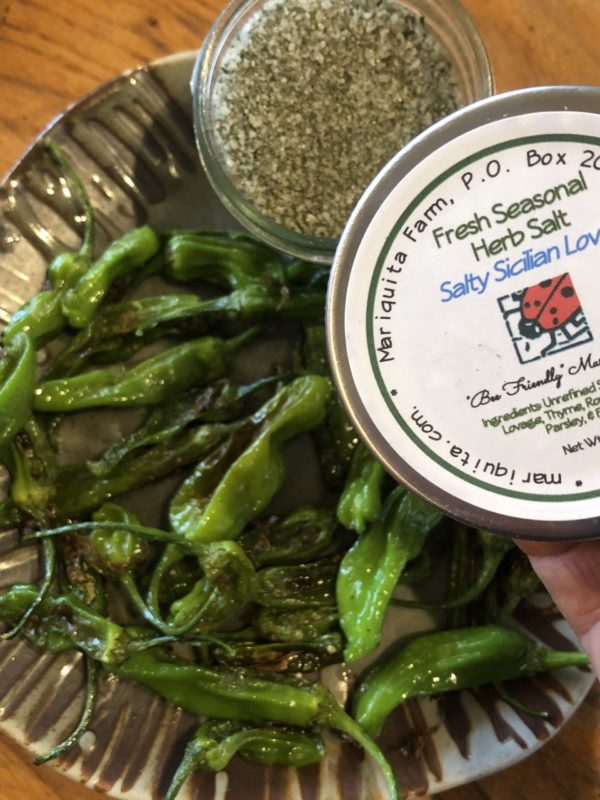
I
Didn’t your mother ever tell you “You can catch more flies with sugar than salt?” Mine didn’t, but I do get the point. If I’m more diplomatic now at 62 than I was at 22, it’s because my naturally salty attitude has been repeatedly humbled by karma and circumstances. Besides; who wants to catch flies? And if salt isn’t any good for catching flies, what is it good for?
Our modern English word “salary,” comes from the Latin word “sal,” for “salt,” and references the “salarium,” or ration of salt that Roman soldiers received for the duration of their military service. Ancient cities, like Salzburg, Austria, were established near the salt mines that were so economically important. It’s not just that a daily measure of salt is essential for our bodies to function. In the ancient world there was no way to refrigerate anything so preserving food often meant drying and salting fresh fruits and vegetables.
Today, we understand that if we overdo our salt intake we can experience some deleterious effects, like high blood pressure. And with electric freezers we aren’t so dependent any more on salt to preserve our foods. But there are still plenty of reasons to employ and enjoy a pinch of salt in the kitchen. In moderation, salt is effective at drawing out flavors from foods and every summer I observe people lightly salting their slices of watermelon.
I prefer to salt my salads. In fact, the word “salad” comes from the Latin “salata,” meaning “salted,” and refers to our human custom of salting the fresh greens we’re going to eat raw. The salt acts to draw a bit of the moisture out of the greens and that contributes to the dressing’s ability to bind the disparate elements of a tossed salad into a piquant, flavorful and cohesive whole. We have added a dash of the herb salt to a pan full of Shishito peppers and lightly salting tomatoes can really “wake them up” in your mouth.
This year, seeing the large supply of fresh herbs that were coming on in our greenhouses, we chose to dry some of our crops and use them to flavor salt. Crops like oregano, thyme, and marjoram need to be repeatedly cut back or harvested so that they stay green and vigorous and don’t become woody and senescent. And we thought we’d have some fun experimenting with some fresh, leafy aromatic herbs like parsley, lovage, and cilantro, too.
For salt we turned to our friends Aaron and Martin. Besides being a professional cook, Aaron represents Marisal, a Mexican cooperative of hand harvested sea salt gatherers in Colima, Mexico. And my friend Martin, besides being a farmer, also sells a range of food products, including his favorite Sicilian sea salt. There are lots and lots of different salts, they range in color, size, texture and moisture levels and the two we chose are different from each other in terms of crystal shape and size so we played around with them for a while and we hope you will too.
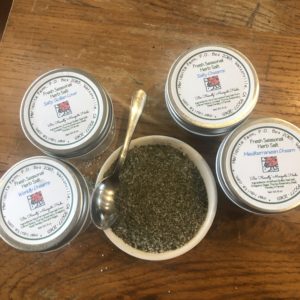 Choose from two sets of two Mariquita Fresh Seasonal Herb Salts.
Choose from two sets of two Mariquita Fresh Seasonal Herb Salts.
The first set:
“Salty Dreams” contains sea salt from Colima, Mexico infused with Lovage, Thyme, Rosemary, Basil, Parsley and Fennel.
“Mediterranean Dream” contains sea salt from Sicily, Italy, a Sea Salt infused with Oregano, Sage, Thyme, Rosemary, Basil, Parsley and Fennel.
The second set:
“Worldly Dreams” contains sea salt from Colima, Mexico infused with Oregano, Sage, Thyme, Rosemary, Basil, Parsley and Fennel.
“Salty Sicilian Love” contains sea salt from Sicily, Italy infused with Lovage, Thyme, Rosemary, Basil, Parsley and Fennel.
You can find our herbal sea salt selections on the farm shop pages. The variety of Mariquita blended herbs adds a nice touch to the salt and will enhance a wide variety of foods. Use as a seasoning for salads, soups, roasts and fish. We even love it on our popcorn!
Enjoy,
Your Friends at Mariquita Farm
—© 2021 Essay by Andy Griffin. Photos by Starr Linden
~Special Note~
As the weather is getting warmer, the sun is rising earlier and the harvesting begins with the sunrise, we will be closing our East Bay/Peninsula shop by 6 PM on the Wednesday evenings before the Friday delivery. We close our San Francisco & Mystery Thursday shops on Wednesday mornings by 8 AM and our Santa Cruz/Los Gatos shop by 8 AM, on Monday mornings. Please get your orders in early so you don’t miss out on the harvest! Thank you all again for being such a part of our bountiful farm!
If you haven’t ordered a Mystery Box recently, now is a great time to get in on spring deliciousness! LadybugBuyingClub
Enjoy the August Harvest
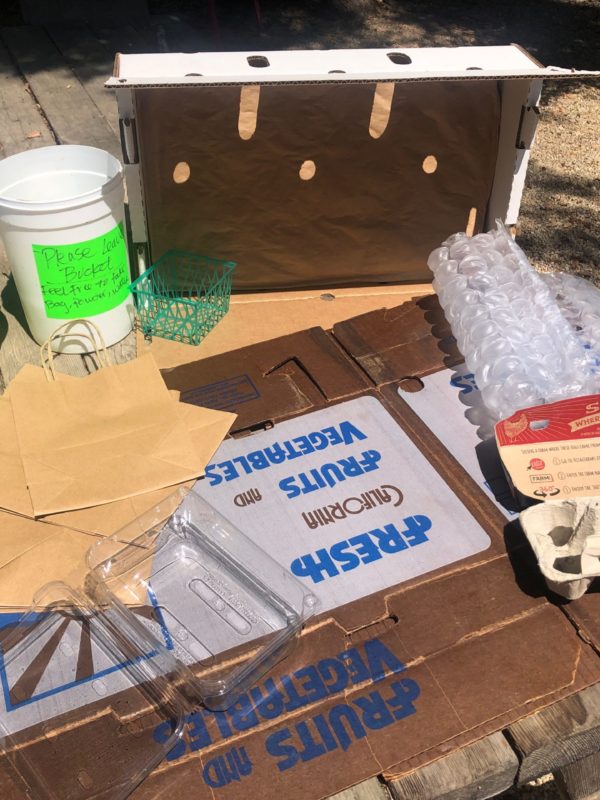
In his effort to liberate India from the British Empire Mohandas Gandhi employed effective political tactics based on principles of non-violence. A generation later, in the United States, the Reverend Martin Luther King preached a strategy of non-violence as he challenged systemic racism and a culture of war. Some people question the wisdom of non-violent political action and ask, “Can pacifism work when peaceful idealists challenge political actors, like Hitler, who have no problem murdering their opponents?” It’s an interesting question but beyond the scope of today’s newsletter. Instead, I’d like to talk about recycling. That said, I assure you that non-violence provides a simple, effective and satisfying approach to employ when opening and closing the waxed cartons that we deliver our produce in. Sometimes when I’m sorting through the re-used cartons I’m shocked at how torn up some of them are- as though wolverines mangled them. It doesn’t have to be that way.
The boxes we use to ship our produce in cost north of $1.75 per carton. When we are able to use the boxes over and over again that $1.75 is amortized over the multiple uses. Each virgin box comes with creases stamped into the cardboard to ease in the folding and unfolding process. Nothing needs to be torn for a box to be successfully opened or closed. To open a box non-violently, just observe where the crease is on the tabs that form the lid of the box and draw back with a pinching motion to free the tabs from the slots in the lid they’ve been pressed into to close and secure the lid. Voila!
To fold the empty cartons up for easy storage simply invert the empty box, observe the crease in the tabs that close and secure the bottom of the box and press them back to unlock the carton. With the top and bottom open the box simply folds up. Stacking the empty, folded cartons, helps keep the pick-up sites presentable and clean. We can save thousands of dollars if we can reuse the cartons many times. Ruined boxes cost money since we have to gather up the damaged cartons and then take them to the dump. They are waxed and therefore, not recyclable in Santa Cruz County. And new boxes keep climbing in price. The paraffin used to “wax” the waxed cartons comes from petroleum so carton costs are tied to the price of oil. Have you noticed how much it costs to fill up a gas tank these days? Paper isn’t getting cheaper either.
Recycling isn’t just good economics- it’s also a gesture of respect to the planet that sustains us. At Mariquita Farm we’re doing whatever we can to avoid wasting resources and we recycle what we can. Please read our list because we cannot take back all the recycling in your home, just the items we can reuse. Here’s a list of what we can re-use. And let us remind you we cannot take back items that are dirty or soiled.
IMPORTANT: Please stack the boxes neatly and leave all other returned items in a tidy manner in the crates at the site. Our hosts have invited us to use their homes and businesses as produce drop spots but we can’t turn them into unauthorized recycling centers.
List of Items we can re-use at Mariquita Farm:
- The full or half strawberry cartons and green plastic baskets that we ship cherry tomatoes in.
2. The white or brown tomato boxes we ship Early Girl tomatoes in. Please return the empty tomato boxes without unfolding them, as they stay stronger for re-use that way. They must be clean and unsoiled.
3. The plastic clamshells that we put tomatoes and sometimes peppers or other items in. Please do not send us clamshells that you receive from other places. We have one size only. They must be clean and unsoiled.
4. If you purchase flowers do not take the container they arrive in. Each bouquet has a plastic bag attached that can be used to transport flowers home in, if needed, and powder which will help prolong their beauty once you put them in a vase.
5. We can always use clean brown paper grocery bags and if you want to recycle the smaller handled bags that your side products from us come in you may also leave them in the crate.
6. We will take egg cartons if they came from us; do not send us egg cartons unless you bought them from us.
7. Lastly, we cannot take back plastic bags of any kind. Please find other ways to use them at home.
Thank you so much for making an effort to reuse these items. Not only will it keep the costs down but also it will save resources for all.
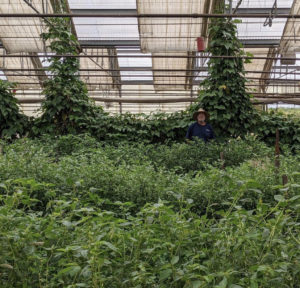 Now back to food, which is what we love to talk about the most. Strawberries make a comeback this week after the birds harvested them last week. Tomatoes are here to stay for a while. At the market customers sometimes ask, “Why are they called “dry farmed?” They look shocked when we tell them that they were transplanted into moist soil but not given any additional water the entire time they are growing. These plants send their roots deep into the mineral earth to find water. The minerals and trace elements found in the deeper soil result in the great tomato flavor you get when you pop one in your mouth or slice one onto a salad. These days our meals are filled with tomato salads and Shishito pepper appetizers. Pan fry a few shishito peppers in Marguerite’s Olive oil and sprinkle with a bit of our herb salt and you have a very good tasty treat.
Now back to food, which is what we love to talk about the most. Strawberries make a comeback this week after the birds harvested them last week. Tomatoes are here to stay for a while. At the market customers sometimes ask, “Why are they called “dry farmed?” They look shocked when we tell them that they were transplanted into moist soil but not given any additional water the entire time they are growing. These plants send their roots deep into the mineral earth to find water. The minerals and trace elements found in the deeper soil result in the great tomato flavor you get when you pop one in your mouth or slice one onto a salad. These days our meals are filled with tomato salads and Shishito pepper appetizers. Pan fry a few shishito peppers in Marguerite’s Olive oil and sprinkle with a bit of our herb salt and you have a very good tasty treat.
Enjoy the August harvest!
Your friends at Mariquita Farm
—© 2021 Essay by Andy Griffin. Photos by Starr Linden
~Special Note~
As the weather is getting warmer, the sun is rising earlier and the harvesting begins with the sunrise, we will be closing our East Bay/Peninsula shop by 6 PM on the Wednesday evenings before the Friday delivery. We close our San Francisco & Mystery Thursday shops on Wednesday mornings by 8 AM and our Santa Cruz/Los Gatos shop by 8 AM, on Monday mornings. Please get your orders in early so you don’t miss out on the harvest! Thank you all again for being such a part of our bountiful farm!
If you haven’t ordered a Mystery Box recently, now is a great time to get in on spring deliciousness! LadybugBuyingClub
Wild Life
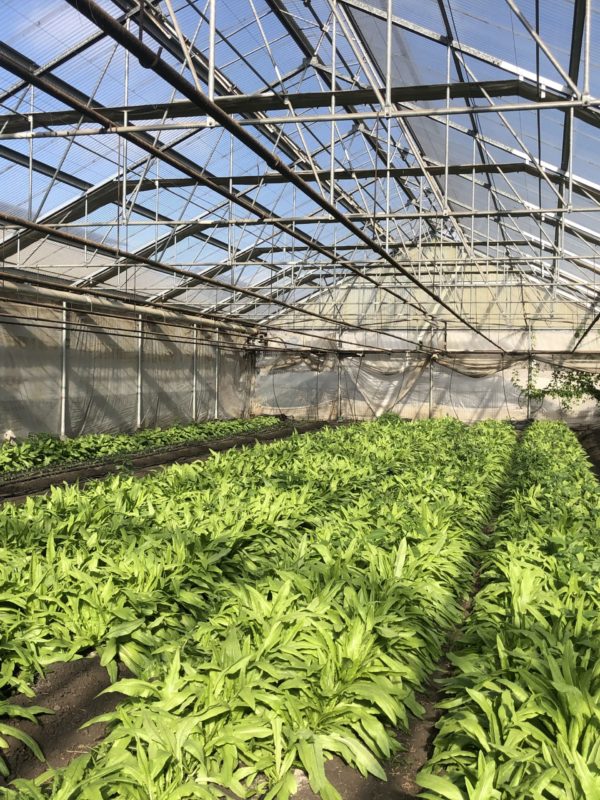
“Back in the day,” as in “back in my great-grandfather’s day,” Watsonville was a “dry town.” A traveler heading on the dirt road out of town, bound for Santa Cruz didn’t need a road sign to tell them they’d reached the city limits because they had the swinging doors of the Whiskey Hill Saloon just over the line welcoming them to the unincorporated county territory. And five miles down the dirt road from Whiskey Hill through the apple orchards that carpeted the area was the first stage stop, a rustic roadhouse appropriately called “The Five Mile House.” Think of it as a 19th century truck stop/convenience store. There was hay and water for the teams of horses and mules and food and drink for the teamsters and travelers.
Except for drought and a persistent overdraft of our aquifer, Watsonville is hardly “dry” these days. I’m farming in a greenhouse complex just down the blacktop highway from the Five Mile House, which in its present day incarnation hosts Blossom’s Farm, a biodynamic cafe and boutique, plus a Mexican restaurant, and a tattoo parlor. Watsonville isn’t five miles away any longer either- it’s more like two miles through the fields from our greenhouse to the Quik Stop and first homes of town. Over the years most of the apple orchards in the Pajaro Valley have been cut down and replaced with strawberries or raspberries, but our little neighborhood still smells like apples in the fall from all the fruit on the ground. It still feels like we’re in the country, not the suburbs, and we have wildlife to deal with.
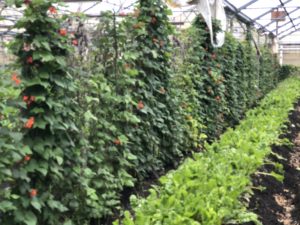 The roof and walls of the greenhouse offer our crops shelter from the weather but they also shelter some critters The same plastic skin that filters the direct sunlight and gives the plants a luxurious, semi-tropical ambiance to thrive in also keeps the hawks and owls from doing their predators’ day and night vigilance, so any rabbits or squirrels that can make it inside have a safe space to munch on lettuces. Yes, I read The Tale of Peter Rabbit to my children when they were young, and I enjoyed the story just as much as they did, and I enjoyed it just as much as I had when my mother read it to me as a child, but I have to admit that as an adult- and a farmer- my sympathies are definitely with Mr. McGregor so the tale is more morally nuanced than it once seemed.
The roof and walls of the greenhouse offer our crops shelter from the weather but they also shelter some critters The same plastic skin that filters the direct sunlight and gives the plants a luxurious, semi-tropical ambiance to thrive in also keeps the hawks and owls from doing their predators’ day and night vigilance, so any rabbits or squirrels that can make it inside have a safe space to munch on lettuces. Yes, I read The Tale of Peter Rabbit to my children when they were young, and I enjoyed the story just as much as they did, and I enjoyed it just as much as I had when my mother read it to me as a child, but I have to admit that as an adult- and a farmer- my sympathies are definitely with Mr. McGregor so the tale is more morally nuanced than it once seemed.
At dawn, when we show up to work the dusty driveways in between the rows of greenhouses that make up the 15 acre complex show a variety of tracks that act as a visitors log for all the nighttime activity. We keep the greenhouse doors tight against any intruders, but there are always raccoon tracks and possum’s tracks. There’s a drain ditch dividing our green houses from the neighboring orchard, which the critters use as a veritable highway. The raccoons would like for nothing more than to remove burrito wrappers from the garbage can in the lunch area and lick the grease and beans from the foil before washing their hands in the ditch water. But neither they, not the possums, do much damage because they’re not that crazy about greens.
Sometimes we’ll see Blue Herons or Snowy Egrets hunting frogs in the ditch. I’m sad for the frogs, but I like to see these beautiful birds hunting. Besides frogs from the ditch, they’ll also eat gophers in the orchards. Gophers migrate under ground and can move miles over time, out of the orchard, under the ditch, under the dirt access road, under the green house walls, and into our plantings, so they’re bad news.
One morning I showed up just in time to see Miss Coyote slip past the water tank and trot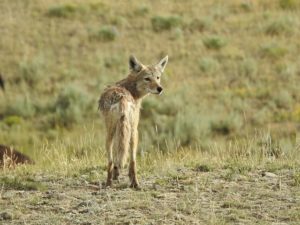 down the alley between two green houses with her nose to the ground following a jack rabbit’s trail. I wished her success. And another morning I was surprised to see a little ferret emerge from a hole under the greenhouse wall and dart into a pile of pallets. Ferrets may be illegal as pets because they’re not native species and they rob songbirds’ nests of eggs, but I welcome them because they are relentless against rats, mice, and baby rabbits and squirrels.
down the alley between two green houses with her nose to the ground following a jack rabbit’s trail. I wished her success. And another morning I was surprised to see a little ferret emerge from a hole under the greenhouse wall and dart into a pile of pallets. Ferrets may be illegal as pets because they’re not native species and they rob songbirds’ nests of eggs, but I welcome them because they are relentless against rats, mice, and baby rabbits and squirrels.
And then there are people to worry about. There’s a cyclone fence with barbed wire and a padlock on the gate that faces what is now a busy highway to help keep out unwelcome human visitors. Because so many local green houses are given over to marijuana cultivation these days we need to keep the place almost hermetically sealed as there are always strangers wanting to enter to see if there’s any weed to steal.
The fence doesn’t enclose the drain ditch though, so we do get people walking back from the highway to investigate what we’re doing. And after 40 years of “Trickle down economics,” there are lots of homeless people in our area, just as there are in the big cities. There have been camps that sprang up back in the shelter of the orchard where the people couldn’t be seen. Some of these homeless folks are actually employed as farmworkers but can no longer pay their rents. We have come to expect to find the toilet paper to be taken from our porta potty from time to time. Sometimes people have broken into the greenhouses and taken harvest knives, hats, water bottles, and ice chests- even the bottles of hot sauce that the crew had left by the table in expectation of the next day’s lunch.
What’s the moral of the story?
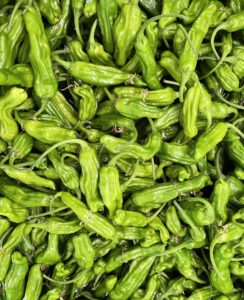 Time marches on and life on the farm is full of surprises. Luckily we have shishito peppers to enjoy flowing from the green houses now. They’re very easy to prepare. One way I like to cook them is to heat up a cast iron skillet and add just enough cooking oil to cover the bottom. Then toss a handful of peppers in- not so many that they cover the pan. Let the peppers toast until browned on one side and turn them. It shouldn’t take long. Then, with a sprinkle of salt you’re good to go. If you put too many peppers in at once they’ll tend to steam, not fry quickly; they’d still be good, but just not the same. The cooking time for the pan fried shishitos is so quick you’ll be able to make a second batch fast before your dinner guests eat them and before you have a chance to enjoy any. If the raccoons ever figure out how to fire up the little camp stove the crew uses to warm their tortillas for lunch we’ll have a real problem in the pepper patch! They know good food when they find it!
Time marches on and life on the farm is full of surprises. Luckily we have shishito peppers to enjoy flowing from the green houses now. They’re very easy to prepare. One way I like to cook them is to heat up a cast iron skillet and add just enough cooking oil to cover the bottom. Then toss a handful of peppers in- not so many that they cover the pan. Let the peppers toast until browned on one side and turn them. It shouldn’t take long. Then, with a sprinkle of salt you’re good to go. If you put too many peppers in at once they’ll tend to steam, not fry quickly; they’d still be good, but just not the same. The cooking time for the pan fried shishitos is so quick you’ll be able to make a second batch fast before your dinner guests eat them and before you have a chance to enjoy any. If the raccoons ever figure out how to fire up the little camp stove the crew uses to warm their tortillas for lunch we’ll have a real problem in the pepper patch! They know good food when they find it!
—© 2021 Essay by Andy Griffin. Photos of greenhouses and shishito peppers by Andy Griffin and picture of Coyote by Pixabay
~Special Note~
As the weather is getting warmer, the sun is rising earlier and the harvesting begins with the sunrise, we will be closing our East Bay/Peninsula shop by 6 PM on the Wednesday evenings before the Friday delivery. We close our San Francisco & Mystery Thursday shops on Wednesday mornings by 8 AM and our Santa Cruz/Los Gatos shop by 8 AM, on Monday mornings. Please get your orders in early so you don’t miss out on the harvest! Thank you all again for being such a part of our bountiful farm!
If you haven’t ordered a Mystery Box recently, now is a great time to get in on spring deliciousness! LadybugBuyingClub
A Sunday Adventure
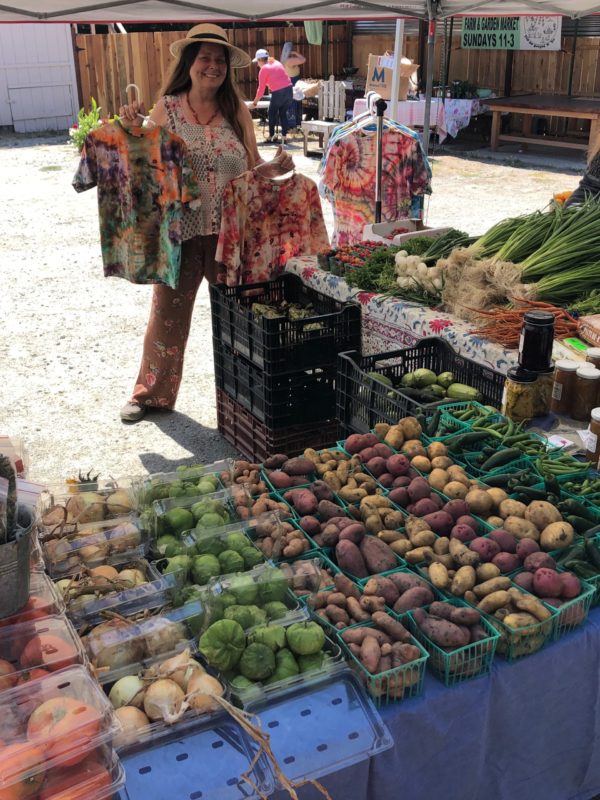
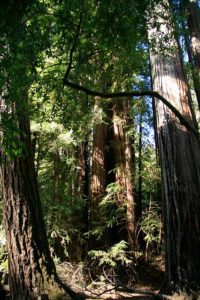 We still have redwoods here, especially in the canyons, but the old growth trees that carpeted the valley are gone. When the Spanish king granted the Amesti family a ranch here, the 14,000 acre parcel was called Rancho Corralitos. Both my home ranch and the greenhouse facility I lease are on lands that were once part of the Rancho Corralitos. When Don Amesti, the Rancho Corralitos landlord, saw fit to lease his property to some German loggers in the 1840s, our little valley became the first place in California for commercial redwood logging. Once the big trees were gone our neighborhood slipped into obscurity until 1905 when the San Francisco earthquake and fire prompted the logging of the second growth redwoods that were needed to rebuild the City.
We still have redwoods here, especially in the canyons, but the old growth trees that carpeted the valley are gone. When the Spanish king granted the Amesti family a ranch here, the 14,000 acre parcel was called Rancho Corralitos. Both my home ranch and the greenhouse facility I lease are on lands that were once part of the Rancho Corralitos. When Don Amesti, the Rancho Corralitos landlord, saw fit to lease his property to some German loggers in the 1840s, our little valley became the first place in California for commercial redwood logging. Once the big trees were gone our neighborhood slipped into obscurity until 1905 when the San Francisco earthquake and fire prompted the logging of the second growth redwoods that were needed to rebuild the City.Farm & Garden Market
Corralitos Cultural Center 127 Hames Road, Corralitos, CA Sunday, 11AM to 3PM
—© 2021 Essay by Andy Griffin and photos by Andy Griffin
Photo of Redwoods by Pixabay
~Special Note~
As the weather is getting warmer, the sun is rising earlier and the harvesting begins with the sunrise, we will be closing our East Bay/Peninsula shop by 6 PM on the Wednesday evenings before the Friday delivery. We close our San Francisco & Mystery Thursday shops on Wednesday mornings by 8 AM and our Santa Cruz/Los Gatos shop by 8 AM, on Monday mornings. Please get your orders in early so you don’t miss out on the harvest! Thank you all again for being such a part of our bountiful farm!
If you haven’t ordered a Mystery Box recently, now is a great time to get in on spring deliciousness! LadybugBuyingClub
Shedding Light on the Nightshade Family
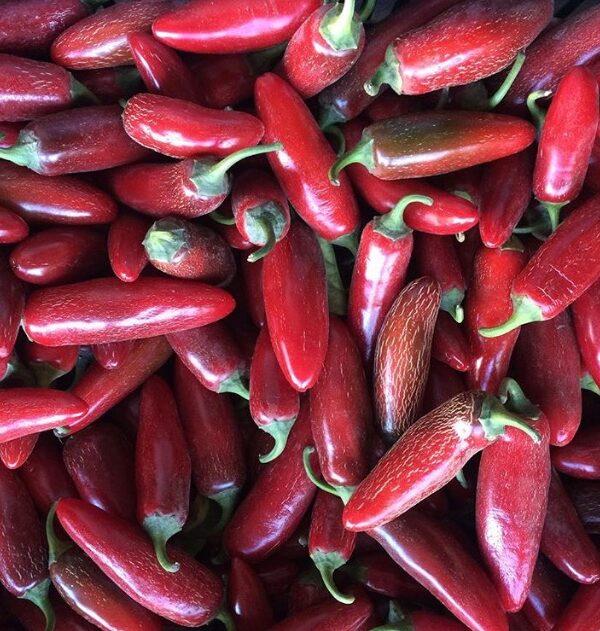
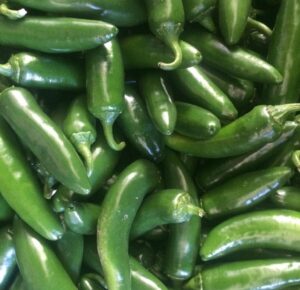 I have never been to Jalapa. I don’t even know any Jalapeños, but I know their peppers. The Jalapeño pepper is one of the most widely adapted pepper varieties across continents and cultures. Smoked jalapeños, or “Chipotles,” are essential in Mexican cuisine. Red, mature Jalapeños are an essential ingredient in Sriracha. Jalapeños put the “pop!” in “poppers,” the food truck favorite that finds the green, bullet shaped peppers stuffed with cheese, then dipped in cornmeal batter and deep fried. Jalapeños are natural in fresh salsas, minced well into ceviche, and add a sting when sliced finely into Thai coconut milk based soups. What’s not to love?
I have never been to Jalapa. I don’t even know any Jalapeños, but I know their peppers. The Jalapeño pepper is one of the most widely adapted pepper varieties across continents and cultures. Smoked jalapeños, or “Chipotles,” are essential in Mexican cuisine. Red, mature Jalapeños are an essential ingredient in Sriracha. Jalapeños put the “pop!” in “poppers,” the food truck favorite that finds the green, bullet shaped peppers stuffed with cheese, then dipped in cornmeal batter and deep fried. Jalapeños are natural in fresh salsas, minced well into ceviche, and add a sting when sliced finely into Thai coconut milk based soups. What’s not to love?
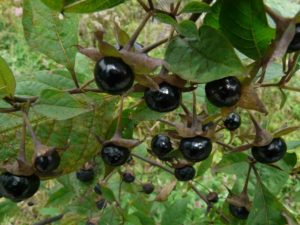 the Solanacea family to the eggplants, peppers, tomatoes etc. Unlike its more commercial cousins, Atropa belladonna, also known as “Deadly Nightshade,” is native to Europe, Africa, and Asia. The nightshade’s little, black berries look like “Goth Cherry tomatoes.” The lavender flowers of poisonous nightshade look like potato flowers. And significantly, the powerful alkaloids that the nightshade berries contain can provoke delirium and hallucinations when ingested in moderation. If you consume Belladonna “immoderately” then you die. Not everybody in old world Europe hung on to the Pope’s every word with fascination; there were witches, for example, whose spiritual path took them far from the catechism of the Patriarchy, and some of them chose to trip on Belladonna. This association gave all nightshade family lookalikes a sinister, diabolic reputation.
the Solanacea family to the eggplants, peppers, tomatoes etc. Unlike its more commercial cousins, Atropa belladonna, also known as “Deadly Nightshade,” is native to Europe, Africa, and Asia. The nightshade’s little, black berries look like “Goth Cherry tomatoes.” The lavender flowers of poisonous nightshade look like potato flowers. And significantly, the powerful alkaloids that the nightshade berries contain can provoke delirium and hallucinations when ingested in moderation. If you consume Belladonna “immoderately” then you die. Not everybody in old world Europe hung on to the Pope’s every word with fascination; there were witches, for example, whose spiritual path took them far from the catechism of the Patriarchy, and some of them chose to trip on Belladonna. This association gave all nightshade family lookalikes a sinister, diabolic reputation.—© 2021 Essay by Andy Griffin and photos of jalapeños by Andy Griffin
Photo of Belladona by Pixabay
~Special Note~
As the weather is getting warmer, the sun is rising earlier and the harvesting begins with the sunrise, we will be closing our East Bay/Peninsula shop by 6 PM on the Wednesday evenings before the Friday delivery. We close our San Francisco & Mystery Thursday shops on Wednesday mornings by 8 AM and our Santa Cruz/Los Gatos shop by 8 AM, on Monday mornings. Please get your orders in early so you don’t miss out on the harvest! Thank you all again for being such a part of our bountiful farm!
If you haven’t ordered a Mystery Box recently, now is a great time to get in on spring deliciousness! LadybugBuyingClub
The Tomatoes are Coming
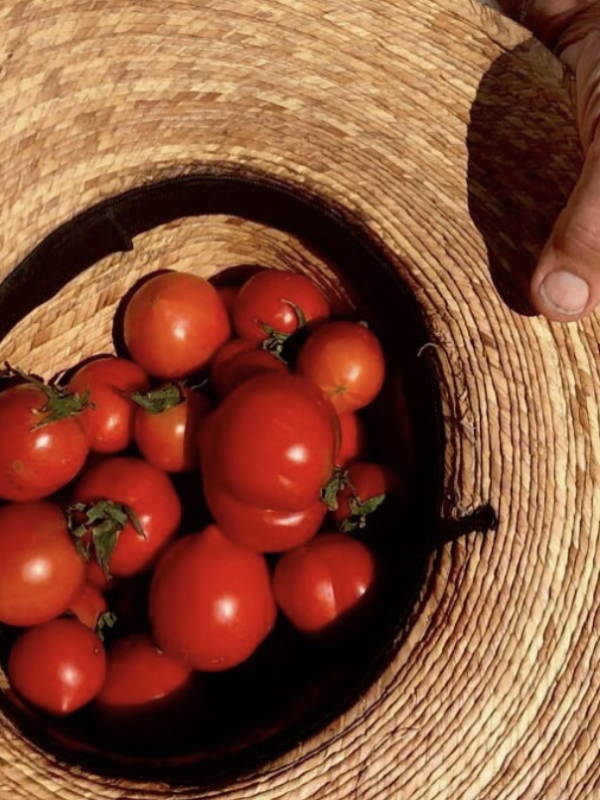
People have been asking when the dry-farmed Early Girl tomatoes and San Marzano tomatoes will be available in bulk for canning.
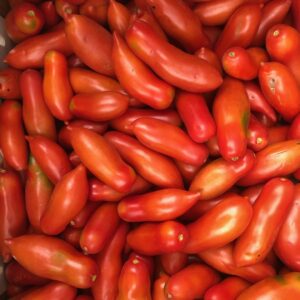 Every year is different because the weather conditions that push or stall the crop vary, but we always plant our tomatoes after the 15th of April and we usually have a nice supply of ripe fruit by late July. Cherry tomatoes are small and ripen quickly so they come first. Early Girls are called “Early” because they are quicker to ripen than some other varieties. San Marzano tomatoes have many virtues, including a rich, thick texture when they’re cooked down into sauce but they’re not “early.” It’s a lot of work to plant out the tomatoes in the spring and we can’t complete the entire task at once, so typically we plant the different varieties out in stages over several weeks. I figure that we’ll have a supply of San Marzano tomatoes starting in mid-August.
Every year is different because the weather conditions that push or stall the crop vary, but we always plant our tomatoes after the 15th of April and we usually have a nice supply of ripe fruit by late July. Cherry tomatoes are small and ripen quickly so they come first. Early Girls are called “Early” because they are quicker to ripen than some other varieties. San Marzano tomatoes have many virtues, including a rich, thick texture when they’re cooked down into sauce but they’re not “early.” It’s a lot of work to plant out the tomatoes in the spring and we can’t complete the entire task at once, so typically we plant the different varieties out in stages over several weeks. I figure that we’ll have a supply of San Marzano tomatoes starting in mid-August.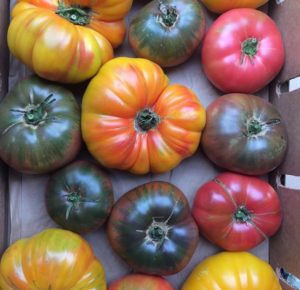 This week we’re starting in on the earliest heirloom tomatoes. Of all of the varieties they’re the most vulnerable to extreme heat and sunscald, so I’m hoping the temps are moderate over the coming weeks. So far so good- the first fruit is always buried in green foliage and protected from the direct rays of the sun. I hope you are too, and I’m hoping you’re as hungry for fresh salsa and Caprese salad as I am.
This week we’re starting in on the earliest heirloom tomatoes. Of all of the varieties they’re the most vulnerable to extreme heat and sunscald, so I’m hoping the temps are moderate over the coming weeks. So far so good- the first fruit is always buried in green foliage and protected from the direct rays of the sun. I hope you are too, and I’m hoping you’re as hungry for fresh salsa and Caprese salad as I am.—© 2021 Essay by Andy Griffin and photos of farm by Andy Griffin
~Special Note~
As the weather is getting warmer, the sun is rising earlier and the harvesting begins with the sunrise, we will be closing our East Bay/Peninsula shop by 6 PM on the Wednesday evenings before the Friday delivery. We close our San Francisco & Mystery Thursday shops on Wednesday mornings by 8 AM and our Santa Cruz/Los Gatos shop by 8 AM, on Monday mornings. Please get your orders in early so you don’t miss out on the harvest! Thank you all again for being such a part of our bountiful farm!
If you haven’t ordered a Mystery Box recently, now is a great time to get in on spring deliciousness! LadybugBuyingClub
Cinderella’s Brunch
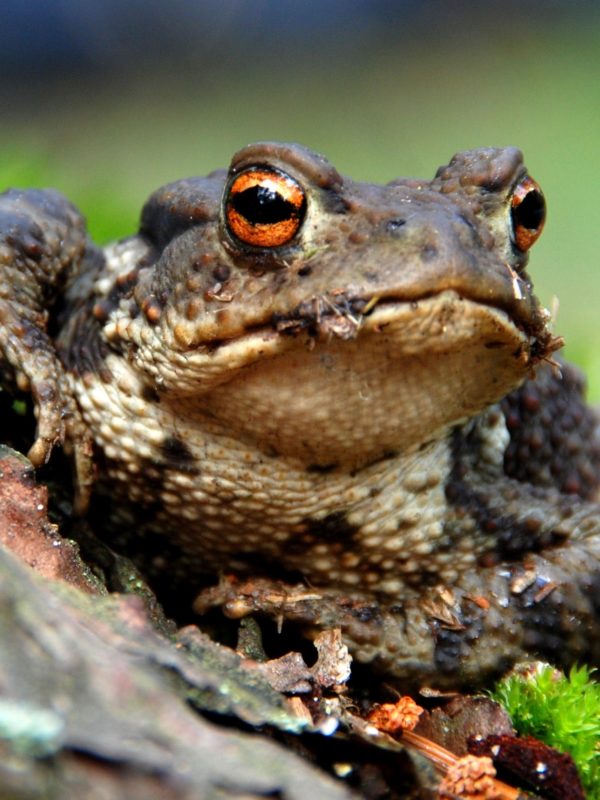
Once upon a time in a land far, far, away Little Red Riding Hood went to brunch with her besties at The Fairy Godmother’s Cauldron. Boots, the waiter, guided her through the crowded room to their regular table. Cinderella was already seated. A Princess with an unusual sensitivity to legumes arrived moments later and, after a round of curtsies and kisses, the three settled into a bucket of Champagne mimosas. The conversation turned to love and relationships.
“Is your Prince still ‘charming,’ ” Red asked Cindy.
Cinderella’s glass was empty. Boots scuttled over and refilled it. She took a sip of the syrupy, sweet drink and took her time in answering.
“I kissed him and he turned into a frog,” she finally replied. The women shared a bitter laugh, and that’s when “It” all started; this disrespect and disinterest the public seems to have for the valiant, valuable, and humble frog. These days the popular press is full of accounts of Prince Andrew’s infidelities and iniquities. Prince Charles’s failed marriage to Diana is the stuff of legend. Accounts of Prince Harry’s trials and tribulations with Meghan Markle are obsessively recounted by the tabloids. But almost nobody pays attention to the plight of our frog friends.
Frogs are amphibians and most species require wetland environments to resolve their romantic and procreative issues. All over the world the frog population is in steep decline as the dramatic reduction in their habitat and the consequences of climate change takes its toll. The decline in frog populations is bad news for humans. Can you name a single prince who has justified his privileged aristocratic status by consuming his weight in mosquitoes? And it’s not just mosquitos; flies and insect pests of all kinds are zapped up by frogs’ long, sticky tongues.
I don’t use any biocides on my farm, be they organically derived pesticides or conventional chemicals. I have distaste for sprays and an unwillingness to subject others or myself to pesticides. But farming without pesticides comes with risks. Sometimes the pests overwhelm a crop of mine and destroy it. But mostly they don’t, and I count on frogs to help control many of the pests that could threaten my greens.
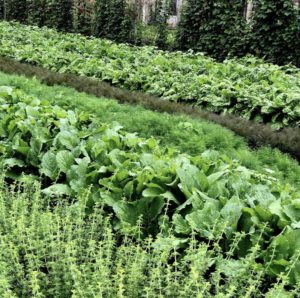 Our greenhouse is next to a ditch that drains farm fields into Corralitos Creek. Our neighborhood frogs romance each other and lay their eggs in the muddy ditch each spring. Then the little frogs that survive all the predators hop their way from their weedy ditch into our greenhouse. The greenhouse roof acts to protect the frogs from airborne threats like Great Blue Herons and Snowy Egrets. Our farm’s happy frogs find a green and moist welcome among the chard leaves and carrot fronds.
Our greenhouse is next to a ditch that drains farm fields into Corralitos Creek. Our neighborhood frogs romance each other and lay their eggs in the muddy ditch each spring. Then the little frogs that survive all the predators hop their way from their weedy ditch into our greenhouse. The greenhouse roof acts to protect the frogs from airborne threats like Great Blue Herons and Snowy Egrets. Our farm’s happy frogs find a green and moist welcome among the chard leaves and carrot fronds.
I manage my greenhouse production by scattering rows of short-term annuals, like arugula, collards, or baby carrots, among rows of long-term annuals like peppers or runner beans and rows of perennial crops like Hoja Santa, or Lemon Verbena. That way, when I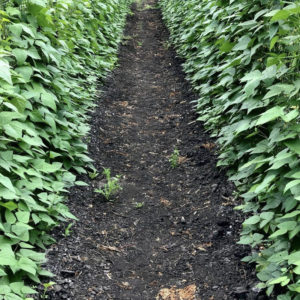 turn the tractor down a spent row that needs to be tilled under and replanted, the frogs that are hiding in the greenery have an opportunity to move to a safe space just a row or two away. I was on the tractor this past week and it was fun to see the frogs hopping out of my way as the tractor crept down the row. When I was tilling under an old bed of overgrown mizuna greens the frogs that bounced out of my way were a lovely jade green, just like the mizuna. When I turned under the red-veined sorrel the frogs were a burgundy bronze, just like the old, ratty sorrel leaves. When I turned under a bed that was covered in dried weeds the frogs that fled were brown and almost yellow, just like the weeds that had been hiding them.
turn the tractor down a spent row that needs to be tilled under and replanted, the frogs that are hiding in the greenery have an opportunity to move to a safe space just a row or two away. I was on the tractor this past week and it was fun to see the frogs hopping out of my way as the tractor crept down the row. When I was tilling under an old bed of overgrown mizuna greens the frogs that bounced out of my way were a lovely jade green, just like the mizuna. When I turned under the red-veined sorrel the frogs were a burgundy bronze, just like the old, ratty sorrel leaves. When I turned under a bed that was covered in dried weeds the frogs that fled were brown and almost yellow, just like the weeds that had been hiding them.
Frogs can change colors to fit their surroundings, which is pretty enchanting. For me, frogs are magic because they eat the carrot flies that hover close to the ground and would lay eggs and spread their little, destructive maggots in among our umbelliferous crops like carrots, parsley, chervil, dill, or lovage. Frogs zap up the white flies that would cling to our pepper crops and chew away at our profits. The sticky, waxy aphids that want to eat our chards and lettuces are held in check by our vigilant posse of little amphibians. If Cinderella kissed a Prince and their relationship didn’t develop into the mutually supportive growth experience that she’d hoped for, that’s because….well, life’s no Fairy Tale. But we do the planet a favor when we host our frog friends by providing them with an amenable habitat, and they never betray our friendship by turning into aristocrats.
—© 2021 Essay by Andy Griffin and photos of farm by Andy Griffin
Photo of frog by Pixabay
~Special Note~
As the weather is getting warmer, the sun is rising earlier and the harvesting begins with the sunrise, we will be closing our East Bay/Peninsula shop by 6 PM on the Wednesday evenings before the Friday delivery. We close our San Francisco & Mystery Thursday shops on Wednesday mornings by 8 AM and our Santa Cruz/Los Gatos shop by 8 AM, on Monday mornings. Please get your orders in early so you don’t miss out on the harvest! Thank you all again for being such a part of our bountiful farm!
If you haven’t ordered a Mystery Box recently, now is a great time to get in on spring deliciousness! LadybugBuyingClub
We Are Stardust
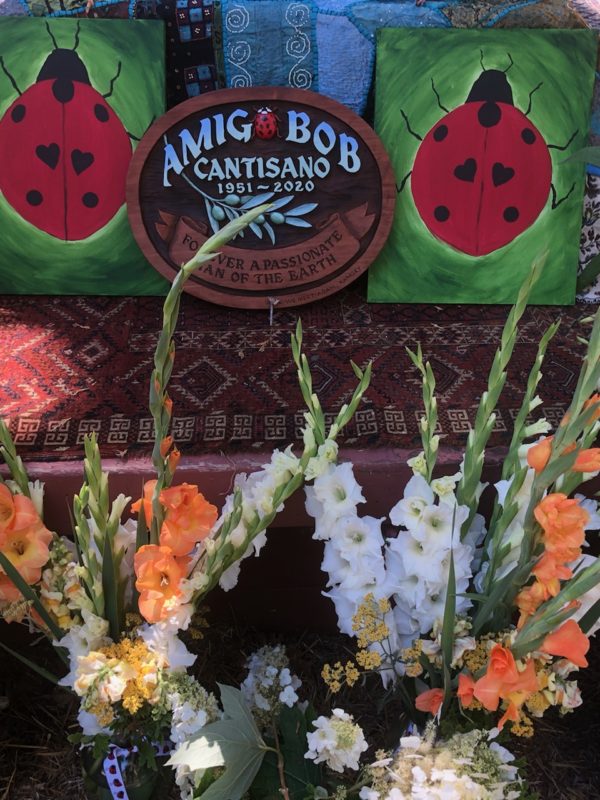
A little country schoolhouse in the woods adjacent to the site of one of America’s most egregious environmental crimes made a perfect setting for the memorial service. A gentle breeze stroked the pines and eased the 102-degree summer heat as the mourners began to arrive. Many folks tumbled out of vans or stepped down from pick-up trucks, brightly dressed for the occasion in their best tie-dyed formal wear as had been suggested by the grieving family. I didn’t see any black in the crowd, but there were also people in colorful prints and stripes, and a few folks chose to wear next to nothing at all. Excited children ran loose on the grass in the sun and there were glass pitchers of iced, herbal teas and lemonade waiting in the shade. You could hear the music of acoustic guitars and harps coming from a duo down by the makeshift altar where the grownups were gathering. There was a life to be celebrated and honored here, but first let’s talk about the crime.
Malakoff Diggins on the San Juan Ridge North of Nevada City in the Sierra Nevada Gold Country is a vast blight on the landscape that has been re-imagined as a State Park. When California’s Gold Rush matured in the mid1850s the business of gold mining became very industrialized. Gone were the days of the ’49ers bent over in a river panning for gold nuggets. Capitalists raised money for mining companies to dam creeks and rivers high in the mountains. Then they’d cut down the pine forests to build wooden sluices that would guide the wild water down from great heights to the lower elevations in the foothills. The sluices would be channeled into huge hoses and, thanks to the tremendous pressure from the dramatic descent, the water exploded out of the nozzles with violent, cutting force. Whole hillsides would be washed away in a muddy torrent and the raging slurry would be strained for gold through a series of sluices. Malakoff Diggins is the scar left from one of the largest hydraulic mines. There are eroded canyons where there once were hills. The soil was washed away down to bedrock so a visitor can see deep into the planet’s bones. The park’s stunted forest is struggling to heal the violated earth.
To California’s 19th Century mining industry, it didn’t matter that her forests were destroyed. It wasn’t relevant to the shareholders of the mining corporations that the mud flows from their hydraulic mining polluted rivers and destroyed fisheries and whole ecosystems. It wasn’t a problem for the mining industry that the waste from hydraulic mining destroyed farm fields and flooded cities and ruined bays and wetlands downstream. The only thing that mattered to the mining companies was extracting gold from the ground as fast and as cheaply as possible. The miners had zero social consciousness and their “industry” was a rape. The only thing the mining companies could have done to behave in a less socially conscious manner would have been to use slave labor.
Eventually, the number of citizen victims in California so vastly outnumbered the handful of capitalists who controlled the hydraulic mining business that it became politically expedient for the California Legislature to pass America’s first environmental legislation and ban hydraulic mining. It helped that the Sacramento River, which passes close by to California’s Legislature, was so full of mud from the mines that it overflowed frequently and flooded the politicians. The law was important not only because it put a halt to an egregious crime against our environment but also because it set precedent by showing how the wellbeing of the body politic was dependent on the wise management of the land and water resources that sustain the community. Maybe that moment when our legislature first acted with an awareness of the environment was an inflection point; at any rate, starting in the late 19th Century there was a growing social awareness of our role in destroying or conserving our shared environment. At first it seemed like only the poets and artists and mystics and bohemian freaks could see our natural world as anything more than a piggy bank to be busted open for coins.
Amigo Bob was born in 1951. Post War America was the boom time for chemical  agriculture. The threat we face from chemical residues in our food and water is never as obvious as a wave of mud spilling over a riverbank but it’s just as real. In the late 50’s consumers were ignorant and didn’t understand about the ways chemical laced runoff from farms was altering and degrading our rivers, lakes, and aquifers. We didn’t have a widespread public understanding of our farmlands as an irreplaceable resource to be conserved. The “modern” in everything was being fetishized and what had been traditionally valued was seen as outdated, so antique varieties of grains, fruits and vegetables were being forgotten from cultivation. The Universities only taught the gospel of “Better Living Thru Chemistry.” But there was also a nascent counterculture springing up that sought to reconnect our society with the natural world that sustains us. Joni Mitchell captured the moment in her song, Woodstock; “We are stardust,” she sang. “We are golden. And we’ve got to get back to the garden.” Amigo Bob had a hippy memorial service because he was a straight up, tie-dyed in the wool, unapologetic and incurable hippy.
agriculture. The threat we face from chemical residues in our food and water is never as obvious as a wave of mud spilling over a riverbank but it’s just as real. In the late 50’s consumers were ignorant and didn’t understand about the ways chemical laced runoff from farms was altering and degrading our rivers, lakes, and aquifers. We didn’t have a widespread public understanding of our farmlands as an irreplaceable resource to be conserved. The “modern” in everything was being fetishized and what had been traditionally valued was seen as outdated, so antique varieties of grains, fruits and vegetables were being forgotten from cultivation. The Universities only taught the gospel of “Better Living Thru Chemistry.” But there was also a nascent counterculture springing up that sought to reconnect our society with the natural world that sustains us. Joni Mitchell captured the moment in her song, Woodstock; “We are stardust,” she sang. “We are golden. And we’ve got to get back to the garden.” Amigo Bob had a hippy memorial service because he was a straight up, tie-dyed in the wool, unapologetic and incurable hippy.
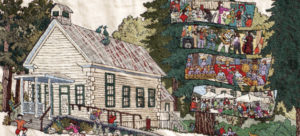 The North Columbia Schoolhouse is a community center for the people who live up and down the San Juan Ridge. The Malakoff Diggins State Park is just around the corner. Amigo Bob may have started off in San Francisco, but he ended up living and farming nearby. What a difference one hundred years makes. Where the gold miners had seen the soil on San Juan Ridge as an obstruction inconveniently hiding treasure, the hippies like Amigo Bob saw the soil as the real treasure. Where the mining companies had no shame in flushing their unfiltered wastes into the whole public’s ecosystem, the hippies envisioned a movement back to the land characterized by a rainbowed network of environmentally sustainable communities where nature was recognized as a partner, not as an adversary. Amigo Bob came out of that loose, nature-centric hippie community and he lived his life as an activist for those life-affirming, scientific, and transcendent values. Amigo Bob put the “active” in “activist.”
The North Columbia Schoolhouse is a community center for the people who live up and down the San Juan Ridge. The Malakoff Diggins State Park is just around the corner. Amigo Bob may have started off in San Francisco, but he ended up living and farming nearby. What a difference one hundred years makes. Where the gold miners had seen the soil on San Juan Ridge as an obstruction inconveniently hiding treasure, the hippies like Amigo Bob saw the soil as the real treasure. Where the mining companies had no shame in flushing their unfiltered wastes into the whole public’s ecosystem, the hippies envisioned a movement back to the land characterized by a rainbowed network of environmentally sustainable communities where nature was recognized as a partner, not as an adversary. Amigo Bob came out of that loose, nature-centric hippie community and he lived his life as an activist for those life-affirming, scientific, and transcendent values. Amigo Bob put the “active” in “activist.”
In the early ’70s Amigo Bob worked with other consumers to create food buying clubs that could source organic, chemical-free foods for the members. When he found that there was very little organic food to be had he started farming. When he ran into the inevitable challenges as an organic grower he began researching organic farm supplies and ended up starting Peaceful Valley Farm Supply in Grass Valley, a first generation organic farm supply business that is still serving the industry today. When the growth of the organic food business created concerns about standards, Amigo worked with others to link farmers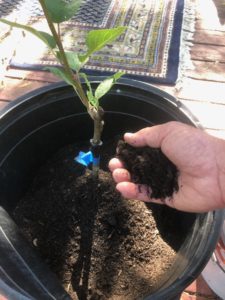 together to craft reasonable, enforceable and transparent standards for the industry. He persisted in trying to get the Universities to work on the challenges facing organic agriculture. When the schools were slow to take up the challenge of learning how to solve agricultural problems organically, Amigo Bob worked with others to create the Eco Farm Conference, which brought farmers, scientists, and activists together. Amigo farmed olives and his olive oil business brought him into the world of fine dining and he helped create an awareness among chefs about the role small farms could play in supplying Restaurant kitchens with fresh ingredients. He worked to save rare and endangered fruit varieties from being lost and he founded the Gillet Institute to institutionalize these goals. https://felixgillet.org/ . Amigo started a farming consulting business to help teach other aspiring and established farmers what he’s learned. For a fitting coda to his life Amigo chose to be composted and turned back into the earth instead of having his body embalmed and boxed up.
together to craft reasonable, enforceable and transparent standards for the industry. He persisted in trying to get the Universities to work on the challenges facing organic agriculture. When the schools were slow to take up the challenge of learning how to solve agricultural problems organically, Amigo Bob worked with others to create the Eco Farm Conference, which brought farmers, scientists, and activists together. Amigo farmed olives and his olive oil business brought him into the world of fine dining and he helped create an awareness among chefs about the role small farms could play in supplying Restaurant kitchens with fresh ingredients. He worked to save rare and endangered fruit varieties from being lost and he founded the Gillet Institute to institutionalize these goals. https://felixgillet.org/ . Amigo started a farming consulting business to help teach other aspiring and established farmers what he’s learned. For a fitting coda to his life Amigo chose to be composted and turned back into the earth instead of having his body embalmed and boxed up.
As an activist Amigo Bob really covered all the bases and his memorial service was a chance for the community that he sprang from and inspired to gather together and say thanks for a life well lived. Amigo will be missed but the crowd that gathered to remember him spanned all ages and the work goes on. Amigo would be happy to see that the environmental values that he promoted are gathering momentum as day-by-day more people learn to see our shared world from a more holistic perspective.
“All of your actions, no matter how small, can have a huge impact on the environment and all the humans and creatures that inhabit it.”
Amigo Bob 1951- 2020
—© 2021 Essay by Andy Griffin and photos by Starling Linden and Andy Griffin
~Special Note~
As the weather is getting warmer, the sun is rising earlier and the harvesting begins with the sunrise, we will be closing our East Bay/Peninsula shop by 6 PM on the Wednesday evenings before the Friday delivery. We close our San Francisco & Mystery Thursday shops on Wednesday mornings by 8 AM and our Santa Cruz/Los Gatos shop by 8 AM, on Monday mornings. Please get your orders in early so you don’t miss out on the harvest! Thank you all again for being such a part of our bountiful farm!
If you haven’t ordered a Mystery Box recently, now is a great time to get in on spring deliciousness! LadybugBuyingClub
For Plants, Everyday is “Sun” Day!
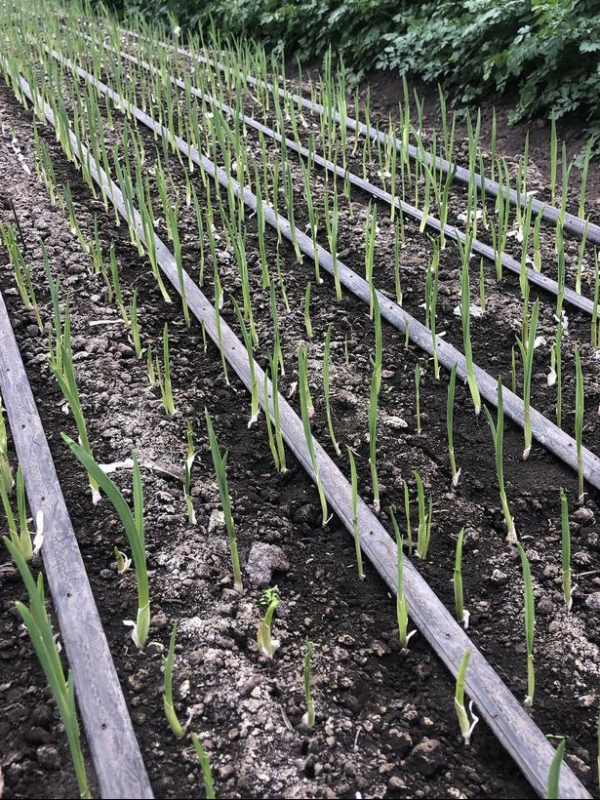
Fathers Day fell on June 20th this year and seemed to get more attention in the media than the Summer Solstice did. But plants noticed the solstice. Maybe it’s just that the plant kingdom doesn’t take strict gender norms as seriously as humans do. The garlic family, for example, is happy to reproduce itself asexually by dispersing cloven clones. Marijuana- and many other plants- are happy to have male, female, and hermaphrodite plants. And plenty of plants, like willow trees, are perfectly comfortable falling over and then rooting into the earth from branches that touch the ground. But if plants don’t follow humanity’s traditional sexual conventions they do all bow to the sun’s power.
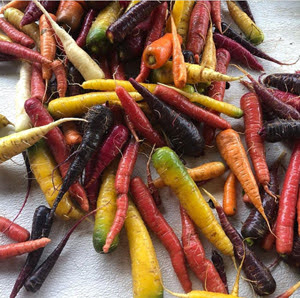 Plants aren’t as dumb as some people think. Many plants, like some of the interesting rainbow colored carrot varieties, will very happily sprout and grow vigorously no matter what time of the year they’re planted- but they won’t form a fat, carrot-like root. But if you plant these day length sensitive varieties after the solstice these carrots will notice that the days are getting shorter. They understand that winter is coming and they’ll form nice, fat, sugar-packed roots so that they have enough stored energy to power the growth of a flower stalk in the following spring. As a consumer, I enjoy purple, red, and even “black” carrots, but as a farmer I know to respect the sensitivities of these kinds of carrots and I wait until after the solstice to plant them.
Plants aren’t as dumb as some people think. Many plants, like some of the interesting rainbow colored carrot varieties, will very happily sprout and grow vigorously no matter what time of the year they’re planted- but they won’t form a fat, carrot-like root. But if you plant these day length sensitive varieties after the solstice these carrots will notice that the days are getting shorter. They understand that winter is coming and they’ll form nice, fat, sugar-packed roots so that they have enough stored energy to power the growth of a flower stalk in the following spring. As a consumer, I enjoy purple, red, and even “black” carrots, but as a farmer I know to respect the sensitivities of these kinds of carrots and I wait until after the solstice to plant them.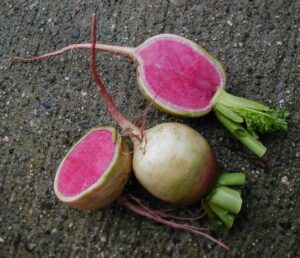 majority of the plant’s growth comes during the declining days after the solstice. The very largest Watermelon radishes are produced by planting right around the summer solstice so that the plant frames up during the longest days and can capture the most energy and make the biggest root. Watermelon radishes planted late in summer or early in fall, will not enjoy as much of the sun’s energy, so they’ll form a smaller root. If you plant these radishes in the dead of winter they’ll sprout alright, but under the influence of the ever longer days after the Winter solstice they’ll “run straight to stick,” as we say, and make a flower stalk without ever forming a root.
majority of the plant’s growth comes during the declining days after the solstice. The very largest Watermelon radishes are produced by planting right around the summer solstice so that the plant frames up during the longest days and can capture the most energy and make the biggest root. Watermelon radishes planted late in summer or early in fall, will not enjoy as much of the sun’s energy, so they’ll form a smaller root. If you plant these radishes in the dead of winter they’ll sprout alright, but under the influence of the ever longer days after the Winter solstice they’ll “run straight to stick,” as we say, and make a flower stalk without ever forming a root.—© 2021 Essay by Andy Griffin and photos by Starling Linden and Andy Griffin
~Special Note~
As the weather is getting warmer, the sun is rising earlier and the harvesting begins with the sunrise, we will be closing our East Bay/Peninsula shop by 6 PM on the Wednesday evenings before the Friday delivery. We close our San Francisco & Mystery Thursday shops on Wednesday mornings by 8 AM and our Santa Cruz/Los Gatos shop by 8 AM, on Monday mornings. Please get your orders in early so you don’t miss out on the harvest! Thank you all again for being such a part of our bountiful farm!
If you haven’t ordered a Mystery Box recently, now is a great time to get in on spring deliciousness! LadybugBuyingClub
Our Lady’s Birds
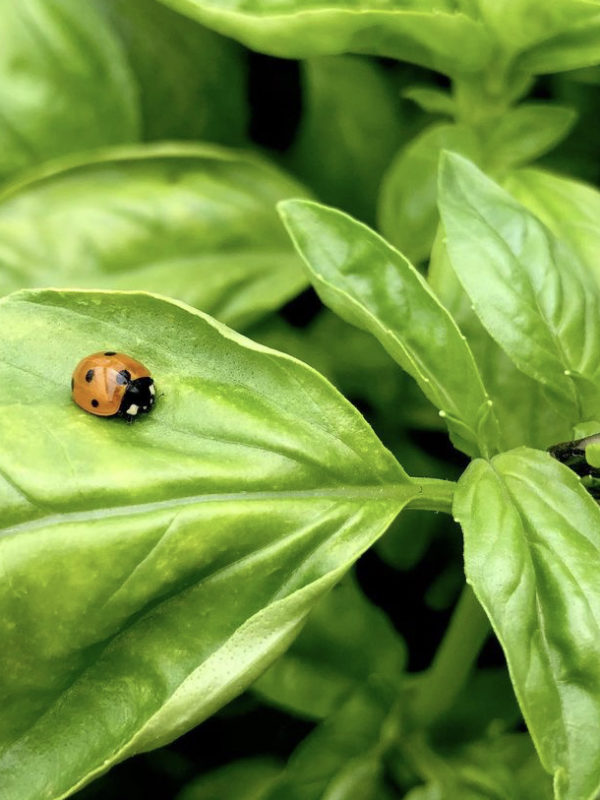
In England, early images of The Virgin Mary often portrayed her wearing a scarlet robe so it made sense from a medieval perspective to call the little red-shelled beetles that made the gardens their homes “Our Lady’s Birds.” The English Seven Spot Ladybird beetle’s “look,” rocking black spots on a shiny red shell is so striking and memorable that it’s image “branded” the entire family forever. When you factor in that the seven black spots on the Ladybird beetle’s shell recall the Virgin Mother’s “Seven Sorrows,” then the name is even richer in meaning. When Our Lady’s Birds crossed the Atlantic to the Americas they got their names changed at Ellis Island, just like so many other immigrants. The name, “Ladybug,” is an Americanism.
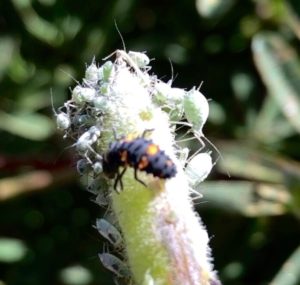 Be they birds, bugs, or beetles, these cute little creatures are fierce predators in the garden and gobble many times their weight in pesty aphids during their lives. Interestingly enough, the Ladybugs that eat the most pests don’t look like Ladybugs at all. Like all beetles, the Ladybugs have a larval form of life before they pupate and become the cute, red shelled, black spotted creatures we love to find in our gardens. The larval, or nymph stage, ladybugs eat a lot more pests than the mature, hard-shelled forms. For the gardener, the goal has to be to create an environment so attractive to the Ladybugs that the mature beetles fly in, have a meal, then decide to lay eggs. If you buy a jar of ladybugs and turn them loose in your garden they may all fly away. So save your money and create the garden they fly to!
Be they birds, bugs, or beetles, these cute little creatures are fierce predators in the garden and gobble many times their weight in pesty aphids during their lives. Interestingly enough, the Ladybugs that eat the most pests don’t look like Ladybugs at all. Like all beetles, the Ladybugs have a larval form of life before they pupate and become the cute, red shelled, black spotted creatures we love to find in our gardens. The larval, or nymph stage, ladybugs eat a lot more pests than the mature, hard-shelled forms. For the gardener, the goal has to be to create an environment so attractive to the Ladybugs that the mature beetles fly in, have a meal, then decide to lay eggs. If you buy a jar of ladybugs and turn them loose in your garden they may all fly away. So save your money and create the garden they fly to!
Planting a mix of perennial and annual plant species will give the Ladybugs a place to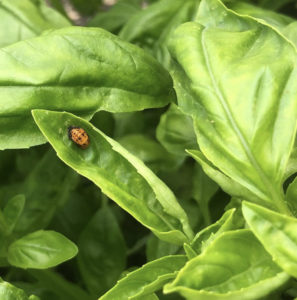 take shelter and lay their eggs even when one part of the garden is being turned under. If you don’t spray your garden with pesticides then some pests will be able to survive, which will give the hatching ladybug larvae something to eat. We aim to create a delicate balance wherein there are enough living pests to support a permanent predator population of Ladybugs, but not so many pests as to damage the crops. At our home ranch we’ve planted a drought tolerant hedgerow at the edge of our citrus orchard that is only a year old, but is already serving as habitat for aphids- and the Ladybugs that feed on them.
take shelter and lay their eggs even when one part of the garden is being turned under. If you don’t spray your garden with pesticides then some pests will be able to survive, which will give the hatching ladybug larvae something to eat. We aim to create a delicate balance wherein there are enough living pests to support a permanent predator population of Ladybugs, but not so many pests as to damage the crops. At our home ranch we’ve planted a drought tolerant hedgerow at the edge of our citrus orchard that is only a year old, but is already serving as habitat for aphids- and the Ladybugs that feed on them.
—© 2021 Essay by Andy Griffin and photos by Starling Linden and Andy Griffin
~Special Note~
As the weather is getting warmer, the sun is rising earlier and the harvesting begins with the sunrise, we will be closing our East Bay/Peninsula shop by 6 PM on the Wednesday evenings before the Friday delivery. We close our San Francisco & Mystery Thursday shops on Wednesday mornings by 8 AM and our Santa Cruz/Los Gatos shop by 8 AM, on Monday mornings. Please get your orders in early so you don’t miss out on the harvest! Thank you all again for being such a part of our bountiful farm!
If you haven’t ordered a Mystery Box recently, now is a great time to get in on spring deliciousness! LadybugBuyingClub


